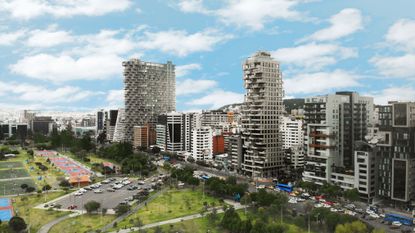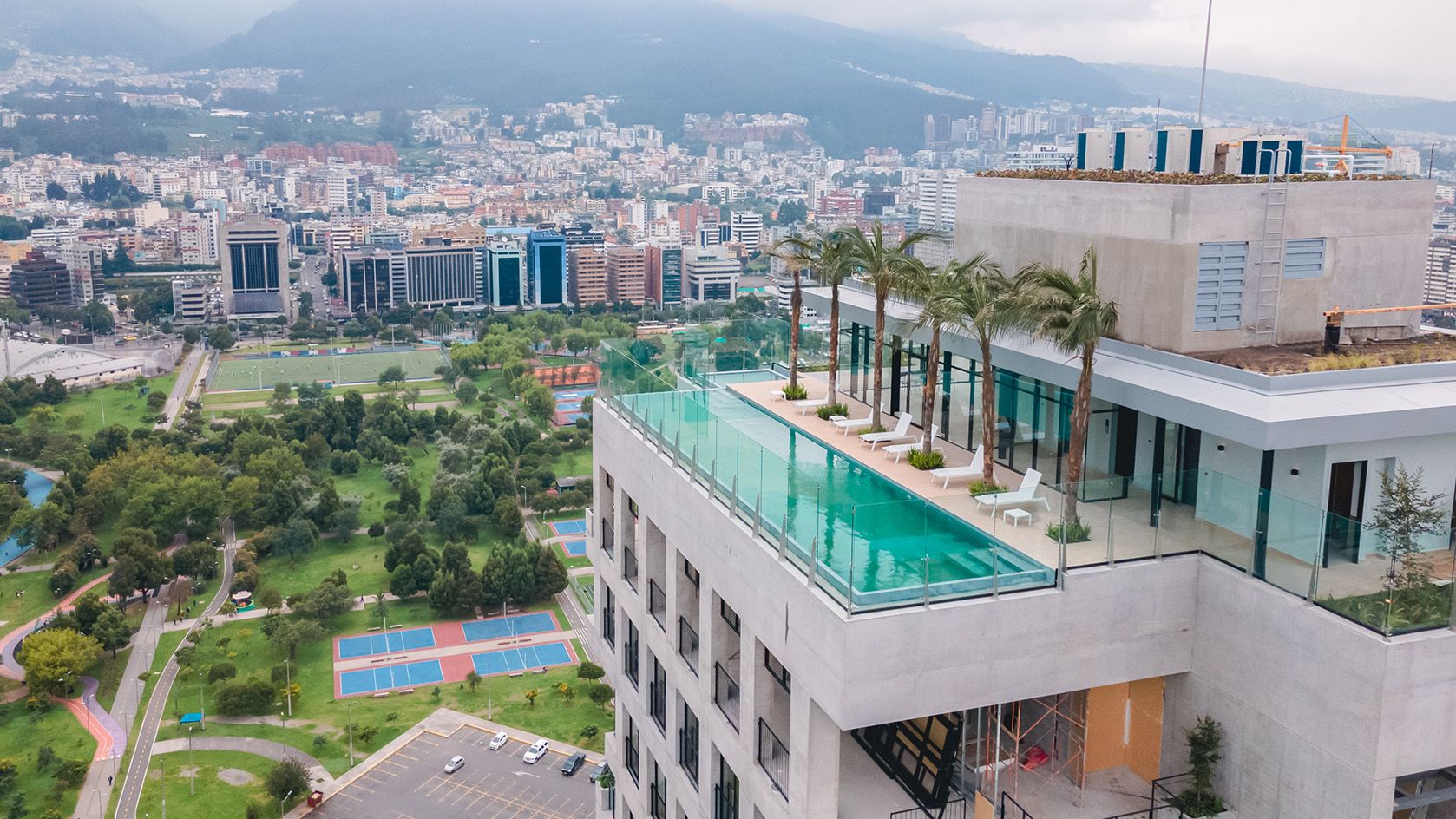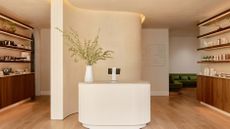Tree-lined tower Qorner adds to Quito’s international allure
Qorner sees Moshe Safdie join a stable of global architects redrawing Quito’s skyline
- (opens in new tab)
- (opens in new tab)
- (opens in new tab)
- Sign up to our newsletter Newsletter

Uribe Schwarzkopf has completed Qorner – a new, fractalised tower by celebrated Israeli architect Moshie Safdie. Adding to its already illustrious collection of adventurous Quito debuts by international heavyweights – Jean Nouvel, Bjarke Ingels and Bernardo Fort-Brescia – the trail-blazing Ecuadorian developer announced the completion of its latest venture this week.
Built on a small corner site, Safdie’s sumptuous design borrows heavily from the playbook of his seminal housing project, Habitat 67 in Montreal, and Holland Village in Singapore, by shuffling the residential tower’s 24-storey deck with delightful irregularity to make room for double-height balconies on the east and west-facing façades.

The penthouse pool
Qorner by Safdie Architects
Winning enough height for each of the irregularly stepped balconies, the architect was able to plant native Arrayan fruit trees, which can grow up to 6m high, and deliver on his mantra 'for everyone, a garden'.
'The climate in Quito really allowed us to open up inside and outside in a dramatic way,' says Sean Scensor, the Safdie Architects partner responsible for projects in Latin America. 'The double-height balconies and the way the windows open up the apartment completely means that each apartment feels like a corner penthouse.'

Taking full advantage of Ecuador’s temperate climate, with mild weather year-round, Safdie used floor-to-ceiling operable glass walls to open the apartments up completely to the tree-lined balconies and frame the stunning views of La Carolina park and the Pichincha volcano to the west.
Despite the façades' complex pattern, each apartment is completely free of internal columns, providing wonderfully clean, uncluttered interiors.

Maximising the interior space in the micro-units on the north-eastern side of the building, the developer hired local architect Jag Studio to come up with a savvy, space-saving solution. The resulting design, named Domestico, has fold-away beds and work stations that offer Airbnb investors and Gen Z students a clever way to use every millimeter of their 27.5 sq m Tokyo-style, piece of Safdie-designed prime Quito real estate.
Uribe Schwarzkopf went all-out on the building’s common areas with a spa and a gym that literally allow residents to look down their nose at joggers in La Carolina park, across from the second floor. There is also a music room and a cinema, as well as a rooftop infinity pool flanked with six wax palm trees that connect with an 85m vertical garden that covers Qorner’s core facing north.

When the jasmine and periwinkle climbing the wall are uplit at night, they’ll make a visual treat for residents of BIG’s brutalist IQON tower, a block north.
With both buildings finishing at almost the same time, there’s a healthy rivalry playing out for the hearts and minds of Quito’s residents, unused to seeing towers over 15 storeys tall. In the red corner, the thrusting, youthful ambition of BIG’s gigantic, geometric intervention, and in the blue, the understated ‘been-there, done-that’ subtlety of Safdie’s carefully crafted cantilevers.

uribeschwarzkopf.com (opens in new tab)
safdiearchitects.com (opens in new tab)
Originally hailing from the UK, Rainbow Blue Nelson first landed in Colombia in search of Tintinesque adventures in 1996. Subsequent forays from his Caribbean base in Cartagena have thrown up a book about Pablo Escobar, and the Wallpaper* City Guides for Santiago, Brasilia, Bogota and Miami. Currently completing a second book about Colombia whilst re-wilding 50 hectares of tropical rainforest on the country's Caribbean coast, he’s interviewed some of South America's most influential figures in art, design and architecture for Wallpaper* and other international publications.
-
 Sage + Sound, a new Upper East Side wellness centre and spa, brings all aspects of self-care under one roof
Sage + Sound, a new Upper East Side wellness centre and spa, brings all aspects of self-care under one roofSage + Sound wellness centre in New York offers an extensive treatment menu of everything from facials to life coaching
By Pei-Ru Keh • Published
-
 New Kindle Scribe crowns 15 years of evolution of Amazon’s e-reader
New Kindle Scribe crowns 15 years of evolution of Amazon’s e-readerWe review the latest and most sophisticated Kindle ever made, the Amazon Kindle Scribe, and look back over the device’s 15-year evolution and how it squares up to rivals like the reMarkable 2
By Jonathan Bell • Published
-
 In memoriam: celebrating the lives and work of those we lost in 2022
In memoriam: celebrating the lives and work of those we lost in 2022We honour and remember some of the influential creatives lost during 2022, through the Wallpaper* tributes that ran throughout the year
By Martha Elliott • Published



